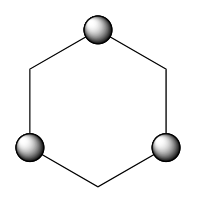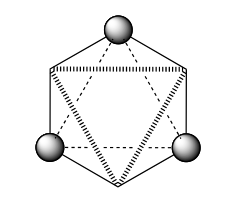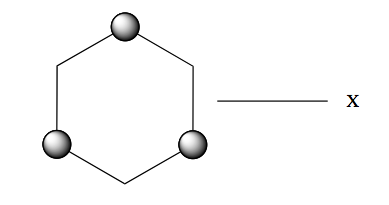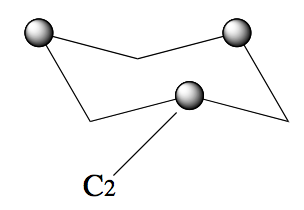Symmetry Workshop 1:demo
Performing symmetry operations on the computer screen: A demo with cyclohexane
You should first spend a little time familiarising yourself with the interface of the GaussView program.
The files you will use for this exercise are input files (extension .com or .gjf) for the Gaussian molecular structure program that GaussView can display, allowing you to view each molecule in 3D.
Select File->Open, and make sure the File Type is set to ‘Gaussian Input Files *.gjf *.com’ and that you are in the directory you have saved the downloaded input files from. Open 0_CYCLOHEX.com.
Mouse buttons :
- left: rotates about axes in the plane of the screen
- middle: translate
- right: rotate perpendicular to the screen and scale
By rotating the molecule from its starting position, you should see a hexagon

where three C atoms are nearer to you. (Make small rotations around the other axes to convince yourself of this).
Work through the flowchart as described below.
- Look down the principal axis of rotation. Is it (i.e. of a turn)? No! This would take an up C atom into a down C atom. It is . Turn to the Flowchart. You have identified the decision in the “SELECT HIGHEST ORDER...” box.
Advice Break
- To help with this, you can open more than one copy of the same structure (open the 0_CYCLOHEX.com file again in another window), and number the atoms (add labels using View->Labels).
Doing this for the
operation will show that the molecule can be moved, but end up in an indistinguishable state.
- Clicking within a window may accidentally add a group to the molecule you’ve opened: undo this with Edit->Undo.
- The next decision involves identifying an , or operation. In this case we have identified n=3 (from the ). Do we have an ? Yes! Remember that is a compound operation (rotation about an axis, followed by reflection in a plane perpendicular to this axis) as illustrated below.
The rotates of a turn, but this is not a symmetry operation. (Try this on the screen by rotating about the axis you are looking down to convince yourself).
The is a reflection at right angles to this that brings atoms that are away from you towards you and vice versa. You can always recognise an from the following figure (i.e. two staggered triangles are interchanged).

- The next decision involves identifying the existence of a axis that is at 90˚ to the principal axis .

To see this more clearly rotate the molecule so that you are looking at it from the side

Then rotate about the
axis. There are two indistinguishable states.
- The last decision involves the identification of . Clearly since the molecule is not planar, this is not a symmetry operation, so the group is where n=3, thus .
- From the point group tables (click here and select point group), the additional symmetry elements are (identity), (inversion) and (diagonal reflection planes; written on the website given).

